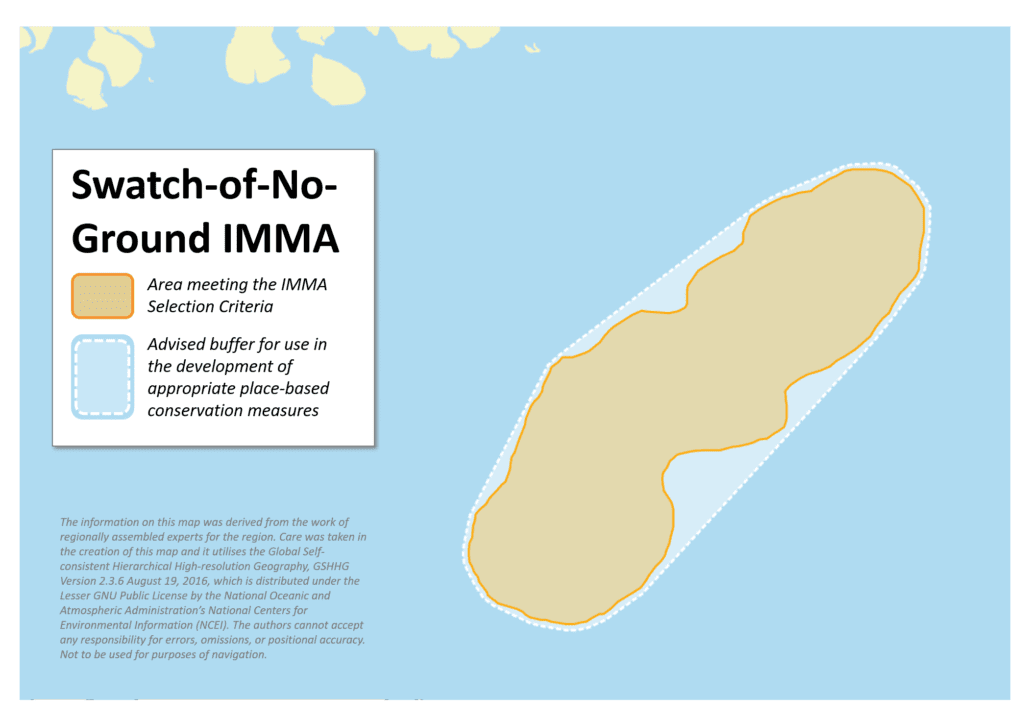Swatch-of-No-Ground IMMA
Size in Square Kilometres
1 960 km2
Qualifying Species and Criteria
Indo-Pacific bottlenose dolphins – Tursiops aduncus
Criterion B (2); D (1)
Bryde’s whale – Balaenoptera edeni
Criterion B (2); D (1)
Marine Mammal Diversity
Stenella attenuata, Stenella longirostris, Steno bredanensis, Pseudorca crassidens
Download fact sheet
Summary
The head of the Swatch-of-No-Ground submarine canyon provides the physical conditions that support extraordinary biological productivity including globally significant populations of Indo-Pacific bottlenose dolphins (Tursiops aduncus) and Bryde’s whales (Balaenoptera edeni) as well as large numbers of spinner (Stenella longirostris) and spotted dolphins (Stenella attenuata) and small numbers of rough toothed dolphins (Steno bredanensis) and false killer whales (Pseudorca crassidens). This qualifies the area as an IMMA under Criterion B2 – Aggregations for the regular concentrations of the species associated with the undersea feature of the canyon, and these aggregations may further imply additional importance for associated foraging and and reproductive behaviours. Finally, it is determined that these locally occurring animals of both species are genetically different from many other populations of the same species in the Indo-Pacific, qualifying the area as an IMMA under Criterion D1.
Description of Qualifying Criteria
Criterion B: Distribution and Abundance
Sub-criterion B2: Aggregations
Productivity at the head of the Swatch-of-No-Ground supports one of the world’s largest aggregations of Indo-Pacific bottlenose dolphins. Although no estimate of population size exists for Bryde’s whales, frequent sightings in the head of the submarine canyon and the general absence of sightings in waters outside of the Swatch-of-No-Ground (Smith, unpublished) imply that the IMMA may also support a globally significant number of a distinctive small form of the species. Frequent sightings of bottlenose dolphin and Bryde’s whale calves in the head of the Swatch-of-No-Ground imply that the IMMA may be particularly important for reproduction in both species. In addition frequent observations of feeding behaviour indicate that the IMMA is particularly important for the reproduction of both species due to the extraordinary productivity in the head of the Swatch-of-No-Ground submarine canyon also reinforces that these important aggregation may be connected to important foraging activities and prey abundances within the IMMA.
Frequent sightings of bottlenose dolphin and Bryde’s whale calves in the head of the Swatch-of-No-Ground imply that the IMMA may be particularly important for reproduction in both species. In addition, frequent observations of feeding behaviour also reinforces that these important aggregations
may be connected to important foraging activities and prey abundances within the IMMA.
Criterion D: Special Attributes
Sub-criterion D1: Distinctiveness
The IMMA supports two cetaceans (Bryde’s whales and Indo-Pacific bottlenose dolphins) that have been the topic of recent studies indicating more complex genetic structure than previously recognized. Although these studies have not identified populations in the IMMA as genetically unique from all other members of their putative species (e.g. Bryde’s whales in the IMMA are closely related to those in Oman while Indo-Pacific bottlenose dolphins in the IMMA are closely related to the African T. aduncus), the disjunctive distribution of both forms of Bryde’s whales and Indo-Pacific bottlenose dolphins and previously unrecognized genetic structure imply a level of genetic distinctiveness from other populations of the same species that meets Criterion Di for designating the area as an IMMA. The bottlenose dolphin population found in the Swatch-of-No-Ground also showed a relatively low level of haplotype diversity, but a high level of nucleotide diversity, which is consistent with a situation where a small population becomes isolated from a source population with higher levels of genetic diversity (Amaral et al. 2016).
Supporting Information
Amaral, A.R., Smith, B.D., Mansur, R.M., Brownell, R.L. and Rosenbaum, H.C., 2017. Oceanographic drivers of population differentiation in Indo-Pacific bottlenose (Tursiops aduncus) and humpback (Sousa spp.) dolphins of the northern Bay of Bengal. Conservation Genetics, 18(2):371-381.
Curray, J. R., Emmel, F. J. and Moore, D. G. 2003. The Bengal fan: Morphology, geometry, stratigraphy, history and processes. Marine and Petroleum Geology, 19:1191–1223.
Kershaw, F., Leslie, M.S., Collins, T., Mansur, R.M., Smith, B.D., Minton, G., Baldwin, R., LeDuc, R.G., Anderson, R.C., Brownell Jr, R.L. and Rosenbaum, H.C., 2013. Population differentiation of 2 forms of Bryde’s whales in the Indian and Pacific Oceans. Journal of Heredity, 104(6):755-764.
Mansur, R.M., Strindberg, S. and Smith, B.D., 2012. Mark‐resight abundance and survival estimation of Indo‐Pacific bottlenose dolphins, Tursiops aduncus, in the Swatch‐of‐No‐Ground, Bangladesh. Marine Mammal Science, 28(3):561-578.
Michels, K. H., Suckow, A., Breitzke, M., Kudrass, H.R. and Kottke, B. 2003. Sediment
transport in the shelf canyon “Swatch of No Ground” (Bay of Bengal). Deep-Sea Research, 50:1103–1122.
Smith, B. D., Ahmed, B., Mansur, R. and Strindberg, S. 2008. Species occurrence and distributional ecology of nearshore cetaceans in the Bay of Bengal, Bangladesh, with abundance estimates for Irrawaddy dolphins Orcaella brevirostris and finless porpoises Neophocaena phocaenoides. Journal of Cetacean Research and Management, 10:45–58.
Subrahmanyam, V., Krishna, K. S. Ramana, M. V. and Murthy, K. S. R. 2008. Marine geophysical investigations across the submarine canyon (Swatch-of-No-Ground), northern Bay of Bengal. Current Science, 94:507–513.


